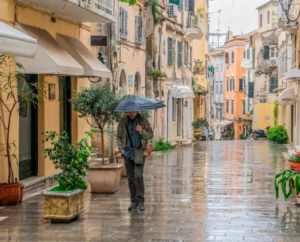Greece is a small country, and one experiencing an economic crisis, but with wealth beyond imagination and a treasure trove of exquisite natural products.
Mastic from Chios (Hios)
Known as “tears of Chios” and chewing gum of the nymphs, the island’s mastic production is granted Protected Designation of Origin (PDO). It is collected at the co-operative of medieval villages, known as Mastichochoria. While there, visit the small Museum of Mastic in the village of Pyrgi.
Pistachios from Aegina
Pistachio nuts produced on the Saronic isle of Aegina are famous for their unique flavor. In 1996, the Aegina Pistachio was registered as a product of PDO in the EU. It is celebrated on the island during the Aegina Fistiki Fest that takes place every year. CLICK HERE for info about this year’s fest from Sept 17-20.
Cherry tomatoes from Santorini
An abbott of the Capuchin monastery in Ano Syros (Cyclades) first brought cherry tomatoes to Greece in 1818. The meager rainfall, blusery weather and soaring temperatures helped Santorini tomatoes thrive on the beautiful island.
Mavrodaphne of Achaea
Created from the black wine grape that is indigenous to the Achaea region in the northwest Peloponnese. The sweet fortified dessert wine was first produced by Bavarian Gustav Clauss at around 1850 and is believed to have been named after his lover named Daphne, who had black eyes and died young.
Olives from Kalamata
Kalamata olives are large purple olives with smooth, meaty textures named after the city of Kalamata in the southern Peloponnese. Kalamata olives in the European Union have a PDO status, whereby only olives originating from the Kalamata region have the right to be branded as Kalamata if sold in the EU.
Fur/leather from Kastoria
High-quality leather suede can be found at Kastoria, northern Greece. The city has a long tradition in the business of trade and lives from the fur business.

Silver from Ioannina
Silversmiths from Ioannina, northwest Greece, are famed for their original modern designs with delicate earrings, intricate chains, ornate buckles etc. There are 90 workshops currently in Ioannina where the silversmiths are recognized as the best of their kind.

Fava from Schinoussa
The tiny Cycladic isle of Schinoussa is famous for the cultivation and production of the Schinoussa variety of fava, known as “katsouni” (meaning “cucumber”) because of its shape.

Lentils from Lefkada
Eglouvi on the isle of Lefkada is known for the excellent quality of its lentils. The quality is due to the organic content of the soil and farming methods that offer lentils of great nutritional value. There is an annual celebration of the lentil with folk dances, lots of free wine and cooked lentils. The celebration takes place on top of the mountain by the small church of Prophet Elijah.
Sponges from Kalymnos
Sponge diving has been called “the oldest profession” on the island of Kalymnos, an activity that has contributed immensely to the economic and social development of the island. The high temperatures in the sea water surrounding the island became the springboard for its thriving songe industry.

Mandolato from Zakynthos
The tasty product is made of honey and roasted almonds. During the Byzantine era, Emperor Justinian loved it so much that he would eat it with Empress Theodora and is believed to be an aphrodisiac.
Greek nightclub singer Angela Dimitriou definitely wants her Greek produce. She wants everything straight from the village, she says:













